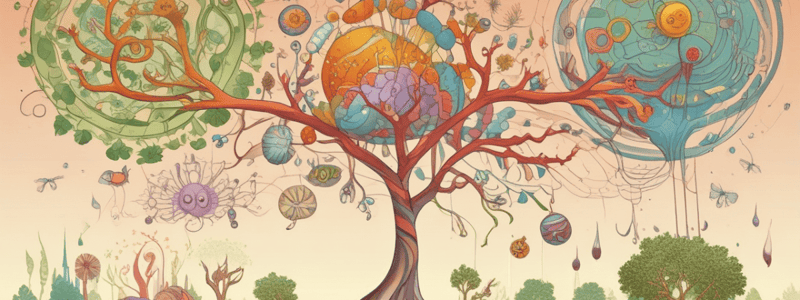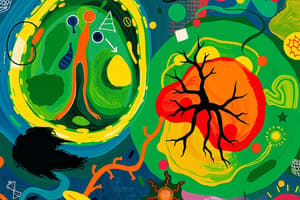Podcast
Questions and Answers
What is the process through which energy is created in our cells?
What is the process through which energy is created in our cells?
- Photosynthesis
- Mitochondrial oxidative phosphorylation (correct)
- Fermentation
- Glycolysis
What are reactive oxygen species?
What are reactive oxygen species?
- Molecules with one or more unpaired electron(s) (correct)
- Molecules that cannot oxidize other molecules
- Molecules with paired electrons
- Stable and non-reactive molecules
What happens to oxidized molecules?
What happens to oxidized molecules?
- They become more stable
- They are eliminated from the body
- They become free radicals themselves (correct)
- They become less reactive
What is a consequence of reactive oxygen species formation?
What is a consequence of reactive oxygen species formation?
Which of the following is NOT a source of reactive oxygen species?
Which of the following is NOT a source of reactive oxygen species?
What is the role of p66Shc in oxidative stress?
What is the role of p66Shc in oxidative stress?
Which enzyme is involved in the formation of reactive oxygen species?
Which enzyme is involved in the formation of reactive oxygen species?
What is a major consequence of reactive oxygen species formation in the body?
What is a major consequence of reactive oxygen species formation in the body?
What is the result of the reduction of oxygen to water in cellular metabolism?
What is the result of the reduction of oxygen to water in cellular metabolism?
What is a characteristic of reactive oxygen species?
What is a characteristic of reactive oxygen species?
What is the function of superoxide dismutases (SODs) in the human body?
What is the function of superoxide dismutases (SODs) in the human body?
Which of the following antioxidants is responsible for scavenging free radicals to buffer against high levels of ROS?
Which of the following antioxidants is responsible for scavenging free radicals to buffer against high levels of ROS?
What is the function of catalase in the human body?
What is the function of catalase in the human body?
What is the role of vitamin C in the human body?
What is the role of vitamin C in the human body?
Which of the following antioxidants is responsible for trapping and scavenging superoxide, hydrogen peroxide, and hydroxyl radicals?
Which of the following antioxidants is responsible for trapping and scavenging superoxide, hydrogen peroxide, and hydroxyl radicals?
What is the function of glutathione peroxidases in the human body?
What is the function of glutathione peroxidases in the human body?
Which of the following antioxidants is related to low-density lipoproteins?
Which of the following antioxidants is related to low-density lipoproteins?
What is the function of albumin, bilirubin, taurine, and hypotaurine in the human body?
What is the function of albumin, bilirubin, taurine, and hypotaurine in the human body?
What is the function of the antioxidant defense system in the human body?
What is the function of the antioxidant defense system in the human body?
Which of the following is an intramitochondrial metabolite?
Which of the following is an intramitochondrial metabolite?
Flashcards are hidden until you start studying
Study Notes
Reactive Oxygen Species (ROS)
- We metabolize oxygen to produce energy through mitochondrial oxidative phosphorylation, which leads to the formation of oxygen free radicals.
- ROS are molecules with one or more unpaired electrons, making them unstable and extremely reactive.
- ROS can oxidize and modify nearby molecules, causing oxidized molecules to become free radicals themselves.
Effects of ROS
- ROS contribute to various diseases and conditions, including:
- Toxic Liver Injury
- Nutritional Liver Disease
- Alcoholism
- Inflammation
- Rheumatoid Arthritis
- Atherosclerosis
- Some Parasitic Infections
- Some Lung Disorders
- Photosensitisation
- Reperfusion Injury
- Tumour Promotion
- Carcinogenesis
ROS-Inducing Compounds
- Examples of compounds that induce ROS include:
- CCl4
- Aromatic nitro-compounds
- Aromatic amines
- Nitrosamines
- Hydrazines
- Quinones
- Adriamycin
Enzymes Affected by ROS
- Enzymes affected by ROS include:
- Monoamino oxidase
- α-Ketoglutarae dehydrogenase
- Glycerol phosphate dehydrogenase
- p66shc (translocates to mitochondrial intermembrane space upon oxidative stress)
Types of ROS
- Two main types of ROS:
- Superoxide anion (intramitochondrial metabolite)
- Hydrogen peroxide (cellular metabolite)
Antioxidant Defense System
- The system includes endogenous and exogenous antioxidants that maintain normal physiological function.
- Antioxidants can be:
- Enzymatic (e.g., SODs, Catalase, Glutathione peroxidases)
- Non-enzymatic (e.g., Glutathione, Vitamin C, Vitamin E, Coenzyme Q-10, Albumin, Bilirubin, Taurine, Hypotaurine)
Functions of Antioxidants
- Antioxidants:
- Scavenge free radicals
- Protect cells from oxygen toxicity and lipid peroxidation
- Decrease lipid peroxidation
- Counteract ROS actions
- Prevent lipid peroxidation and reduce DNA damage
- Recycle other antioxidants
- Inhibit pro-oxidant capacity
- Reduce the risk of oxidative stress development
Studying That Suits You
Use AI to generate personalized quizzes and flashcards to suit your learning preferences.




